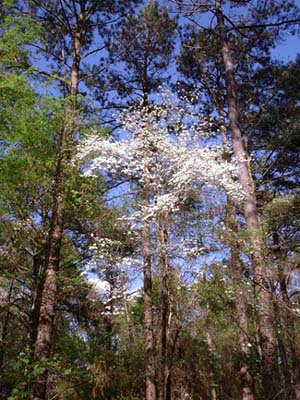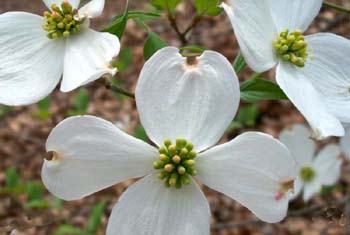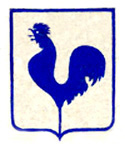 |
Stories & Legends
The Legend of the Dogwood
Elaine M. Jordan
A wondrous show of nature begins this time of the year. The American dogwood begins to bloom. The flowering is brief but glorious. The ethereal pink or white flowers float against the backdrop of the bare branches of taller neighbors in the forest landscapes. The beauty of the delicate flowers seems all the more precious and exquisite because of its brevity.

A stark white dogwood blossoms stand out in the forest |
The dogwood has a long history in the United States. Its name supposedly arises from the extremely hard wood of its slender branches, which made it ideal for making ‘dags’ – daggers or skewers. The North American Indians used its wood for arrows. Other smalls items requiring hard, strong wood like tool handles, wine or fruit presses, loom shuttles, mallets, butcher blocks, even knitting needles – anything requiring extremely durable and dense wood. This and other utilitarian information is what we can read about the dogwood in our science and botanical books.
Its past, however, is far more noble and poetic than the mere utilitarian functions it came to serve. Long before the dogwood took its scientific name of cornus florida [flowered horn], in a less utilitarian age when the wonders of nature reminded man first and foremost of the Creator, the dogwood had a different significance. A legend was born that associated the dogwood with the Crucifixion of Christ.
And what could be more natural? When the dogwood began to bloom so brilliantly and delicately in the Spring, the medieval man of Catholic Europe was immersed in the Passion of Our Lord Jesus Christ. Everything around him spoke to him of His bitter suffering and marvelous work of redemption.
Each delicate white or pink blossom of the dogwood has the form of a cross – two long and two short petals. Look closely at a dogwood flower and you will see on the center of the outer edge of each petal there are small holes remindful of nail prints, and the tips of the petals are rusty on one side and brown-red on the other. It is not hard to imagine they represent the spikes that pierced the Hands and Feet of Our Lord on the Cross. And in the center of the flower there is a green cluster that recalls the crown of thorns.

The dogwood petal - mindful of the Cross of Our Lord |
And so the legend of the dogwood was born. This is one common version:
At the time of Our Lord’s Crucifixion, the dogwood used to have the size of the oak and other forest trees. Because the wood was so firm and strong and there were few trees in the Middle East that were very large, it was chosen to be the wood for the crosses used in crucifixions of criminals.
Thus, the wood of the cross that would bear Our Lord and Savior was made from the dogwood tree. To be used thus for such a cruel purpose, however, greatly distressed the tree. Sensing this, the crucified Christ said to it:
“Because of your compassion and pity for My suffering, never again shall the dogwood tree grow large enough to be used as a cross. Henceforth, you shall be slender and bent and twisted and your blossoms shall be in the form of a cross.
“On the outer edge of each petal there will be nail prints, and the center of the flower will resemble the cruel crown of thorns placed on My head, with bright red clusters once again recalling the blood I shed. Thus, all who see this will remember Me.”
When and where the legend first appeared is unknown. But the “how” of its origin is clear. It was a spontaneous reaction of a people who were deeply familiar with the Life, Death and Resurrection of Our Lord, and who saw imprints of it everywhere in nature. It was a profound love of Christ that inspired the legend.
This beautiful way of viewing the universe has almost disappeared in our own jaded, cynical age supposedly based on science and packed with technology. Sadly, the dogwoods are also withering and fading. There used to be fine dogwood stands throughout Virginia, my octogenarian neighbor tells me. But in the 70s and 80s the disease called Dogwood Anthracnose invaded and has devastated much of the native wild dogwood trees in the forests of the United States. Today’s flowering dogwoods are only a fraction of what they were in the past.
I find this very symbolic. As man removes himself from God and violates the laws of nature, creation itself loses some of its richness and beauty. Think back and remember a time when there were more butterflies, the bluebonnets were thicker and the dogwood blossoms blanketed the first days of spring with a much thicker cover. Will those days return? I believe so.
There will be an invigoration even in nature when man again turns to God and His Blessed Mother with an even greater love and devotion than of old. Then, in the Reign of Mary that Our Lady predicted at Fatima, man will again seek the deeper significance of all things in Creation.

Posted April 16, 2009


Related Topics of Interest
 Make your Mary Garden Now Make your Mary Garden Now
 Naivety or a Higher Understanding of Things? Naivety or a Higher Understanding of Things?
 The Middle Ages, a Forest Filled with Symbols The Middle Ages, a Forest Filled with Symbols
 Roses and the Rosary Roses and the Rosary
 Gargoyles and Original Sin Gargoyles and Original Sin
 Vice and Virtue Symbolized in Animals Vice and Virtue Symbolized in Animals
 The Symbol of the Crown in the Reign of Mary The Symbol of the Crown in the Reign of Mary

Related Works of Interest
|
|
Legends | Religious |
Home | Books | CDs | Search | Contact Us | Donate

© 2002-
Tradition in Action, Inc. All Rights Reserved
|
 |
|